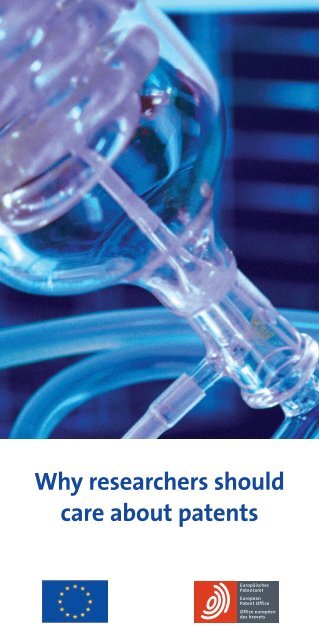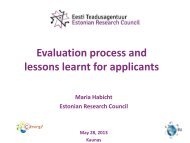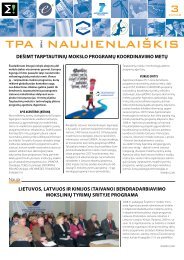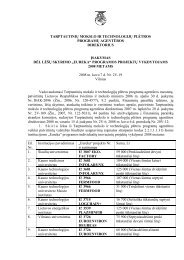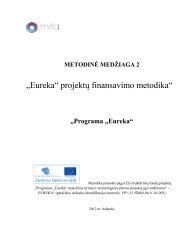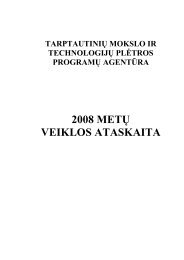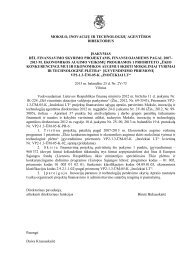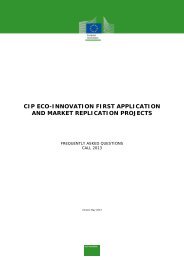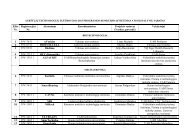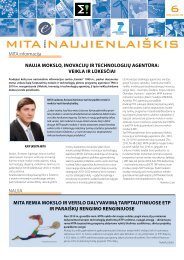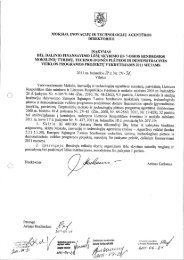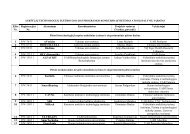Why researchers should care about patents? - European Commission
Why researchers should care about patents? - European Commission
Why researchers should care about patents? - European Commission
You also want an ePaper? Increase the reach of your titles
YUMPU automatically turns print PDFs into web optimized ePapers that Google loves.
<strong>Why</strong> <strong>researchers</strong> <strong>should</strong><br />
<strong>care</strong> <strong>about</strong> <strong>patents</strong>
<strong>Why</strong> <strong>should</strong> I search patent literature<br />
Before starting a R&D-project, an effective study of<br />
the state of the art is useful and advisable. It <strong>should</strong><br />
not only focus on books and scientifi c journals, but<br />
also take patent information into account.<br />
The patent system is the most prolifi c and up-todate<br />
source of information on applied technology.<br />
Patents contain detailed technical information which<br />
often cannot be found anywhere else: up to 80%<br />
of current technical knowledge can only be found<br />
in patent documents. Moreover, this information is<br />
rapidly available, as most patent applications are<br />
published 18 months after the fi rst fi ling, irrespective<br />
of their country of origin.<br />
Searches in patent literature can be conducted by<br />
anyone by using the free-of-charge esp@cenet<br />
patent data base on the Internet. It provides access<br />
to more than 60 million patent documents from<br />
all over the world. All documents are classifi ed by<br />
technological areas on the basis of the International<br />
Patent Classifi cation which is the world-wide<br />
standard.<br />
2
There are good reasons to search patent literature:<br />
• Avoid duplication of R&D efforts and spending<br />
Patents are the broadest source of technical<br />
information. Many companies do not disclose<br />
their R&D results in any other form. Looking<br />
up <strong>patents</strong> therefore is an effi cient way to<br />
avoid duplication of R&D work: up to 30% of all<br />
expenditure in R&D is wasted on redeveloping<br />
existing inventions.<br />
• Find solutions to technical problems<br />
Even if a patent is still in force, the information it<br />
contains can be freely consulted, and used for<br />
experimental purposes (under certain conditions).<br />
Given that the majority of all <strong>patents</strong> – around 85%<br />
– are no longer in force, a vast number of inventions<br />
is available for free.<br />
• Gather business intelligence<br />
Patent information not only reveals the state of<br />
the art in a certain technology areas, but also<br />
enables monitoring the innovation strategies of<br />
competitors and other players at a very early<br />
stage.<br />
It is important to recall that, in the context of<br />
the <strong>European</strong> Community R&D Framework<br />
Programmes, participants need to demonstrate the<br />
innovative character of the project they propose.<br />
A proper analysis of the state of the art is one of<br />
the criteria project proposals are evaluated upon,<br />
and therefore technology-based proposals <strong>should</strong><br />
preferably include patent searches.<br />
3
<strong>Why</strong> and when <strong>should</strong> I consider<br />
patenting in a R&D project<br />
Patents grant their owner a monopoly over<br />
an invention (a product or process that is new,<br />
involves an inventive step and is susceptible of<br />
industrial application) as defi ned by the “claims”.<br />
<strong>European</strong> <strong>patents</strong> are only granted after a thorough<br />
examination procedure which can lead to the grant<br />
of a patent or the rejection of the application or a<br />
limitation of its scope. It is advisable to entrust the<br />
preparation and processing of a patent application to<br />
a skilled professional, for instance a patent attorney,<br />
as this requires detailed knowledge of the applicable<br />
rules and procedures.<br />
The legal protection conferred by a patent gives its<br />
owner the possibility to prevent others from using,<br />
manufacturing, selling, importing, etc. the invention<br />
in the country or countries concerned, during up<br />
to 20 years from the fi ling date. This provides the<br />
patentee with a competitive advantage.<br />
Patents can also be licensed or used to help create<br />
or fi nance a spin-off company. It is therefore possible<br />
to derive value from them even if their owner does<br />
not have its own manufacturing capability<br />
(e.g. universities). The patenting process <strong>should</strong><br />
form a part of the overall innovation and business<br />
strategy envisaged for the invention. The timing of<br />
that process strongly depends on this strategy, on<br />
the sector concerned, etc.<br />
In many cases it is appropriate to keep an invention<br />
secret before fi ling a patent application. Indeed, any<br />
disclosure, for instance at a trade fair, in a catalogue<br />
or at a conference, if it takes place before fi ling,<br />
would render the invention unpatentable.<br />
4
Inventors – including academics 1 – <strong>should</strong> therefore<br />
consider the benefi ts of fi ling a patent as soon as<br />
possible in their research activities (anyway before<br />
any publication).<br />
Moreover, <strong>patents</strong> are not the only form of<br />
knowledge protection. In some cases it may be<br />
appropriate to keep an invention confidential (trade<br />
secret), or to place it in the public domain in order<br />
to freely share it with other users while preventing<br />
future patenting by third parties. The respective<br />
decisions (at least for patenting and confi dentiality)<br />
need to be taken before the invention is published in<br />
any way.<br />
For different legal reasons, <strong>researchers</strong> are advised<br />
to maintain laboratory notebooks according to<br />
proper standards 2 , to help prove when an invention<br />
was developed and by whom.<br />
It is fi nally recalled that, in the EC‘s Framework<br />
Programmes, there is an obligation for participants<br />
to protect any results which are “capable of industrial<br />
or commercial application”.<br />
1<br />
Interestingly, <strong>patents</strong> now form part of the background literature<br />
which is referred to in certain top scientific journals such as Nature.<br />
2<br />
see e.g. www.btgplc.com/btguploads/BTG_LabNotebook_Mar06.pdf<br />
5
Respecting third parties’ rights<br />
While this may look strange, it is important to note<br />
that a patent does not automatically authorise<br />
its owner to carry out, produce or market the<br />
patented invention. Indeed, it is possible that a<br />
patented invention is an improvement of pre-existing<br />
techniques, which may themselves be patented<br />
and would then require the authorisation (typically a<br />
license) from the patent owner(s) concerned.<br />
Therefore, companies and businesses wishing<br />
to use a certain technique (manufacture it, sell<br />
it, import it, etc.) need to identify possible patent<br />
rights of their competitors and other players before<br />
any actual use of the technique (or marketing,<br />
importation, etc.). A search performed by a patent<br />
information specialist, combined with a detailed<br />
legal analysis of the potentially relevant <strong>patents</strong><br />
and patent applications, can help identify possible<br />
blocking <strong>patents</strong> and avoid violation of other parties’<br />
rights. It <strong>should</strong> be borne in mind that infringement<br />
(counterfeiting) can have severe judicial and fi nancial<br />
consequences.<br />
Where appropriate, similar analyses <strong>should</strong> also<br />
be carried out in respect of potentially relevant<br />
trademarks, industrial designs, copyrights, etc.<br />
For more information, see: www.wipo.int/sme/en/<br />
documents/wipo_magazine/9_2005.pdf<br />
6
Some facts <strong>about</strong> patent documents<br />
Patent documents consist of:<br />
• a fi rst page comprising basic information, such<br />
as the title of the invention and the name of the<br />
inventor, etc.<br />
• a detailed description of the invention, indicating<br />
how it is constructed, how it is used, and what<br />
benefi ts it brings, compared with what already<br />
exists<br />
• claims which are a clear and concise defi nition of<br />
what the patent legally protects<br />
• drawings<br />
7
Where can I get more help and<br />
information <br />
• National patent offi ces<br />
www.epo.org/focus/ip-webguide/<br />
IPoffi cesmembers.html<br />
• <strong>European</strong> Patent Offi ce<br />
www.epo.org<br />
esp@cenet database:<br />
www.espacenet.com<br />
Other patent information products:<br />
www.epo.org/patent-information<br />
• PATLIB Centres<br />
(Patent information, technology watch):<br />
www.epo.org/<strong>patents</strong>/patent-information/<br />
patlib.html<br />
• National and <strong>European</strong> patent attorneys<br />
information and professional assistance on how<br />
to patent my invention, how to enforce my rights,<br />
…<br />
The database of professional representatives:<br />
www.epo.org/<strong>patents</strong>/Grant-procedure/<br />
representatives.html<br />
• IPR Helpdesk<br />
(assistance on the IPR rules of the EC<br />
Framework Programmes; general information<br />
<strong>about</strong> IPRs):<br />
www.ipr-helpdesk.org<br />
Jointly published and edited by <strong>European</strong> <strong>Commission</strong> (DG Research) and the<br />
<strong>European</strong> Patent Offi ce © 2007<br />
Photos: © <strong>European</strong> Patent Offi ce, gettyimages, Design: EPO Desktop Publishing


